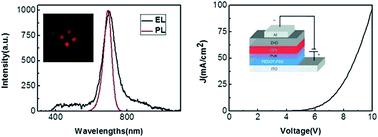Design and assembly of an aqueous red CdTe QD-LED: major factors to fabricate aqueous QD-LEDs†
Abstract
The first aqueous red CdTe QD-LED was fabricated with the structure of ITO/PEDOT:PSS/PVK/CdTe QDs/ZnO/Al. The device has been considered to be an advanced aqueous QD-LED, which demonstrated a turn-on voltage of about 5 V. Further, its current density and brightness would also reach 92 mA cm−2 and 58 cd m−2 at the voltage of 10 V. Moreover, we found that there were two essential factors for fabricating an aqueous QD-LED successfully: (1) adding wet agent to the QD solution, (2) removing the composite ions remaining in the QD solution. Meanwhile, the EL intensity of the aqueous QD-LEDs will perform better if the solution of QDs is acidic. These results offer a promising approach to the further development of aqueous QD-LEDs.


 Please wait while we load your content...
Please wait while we load your content...